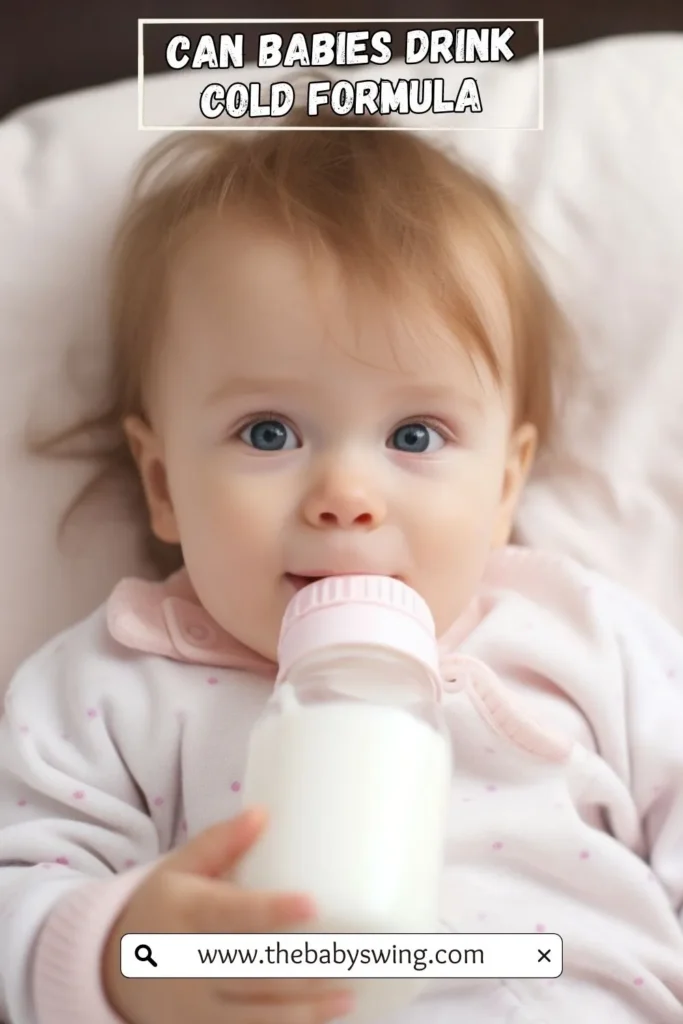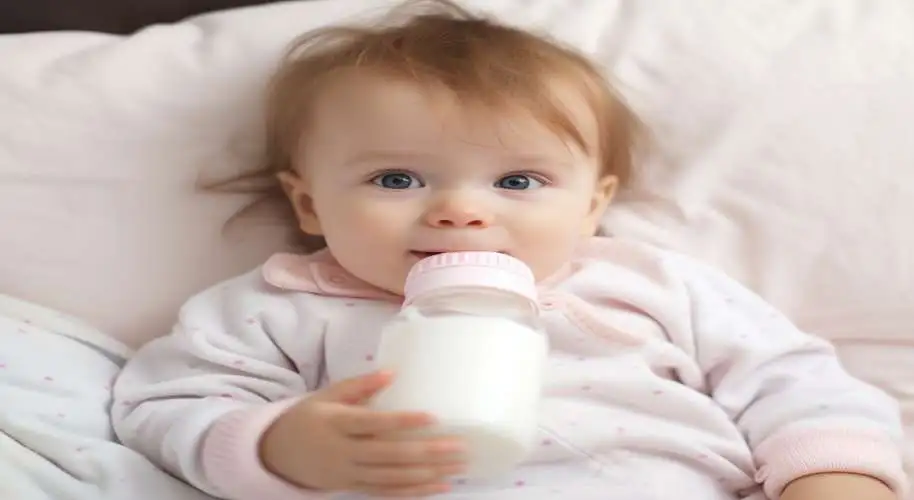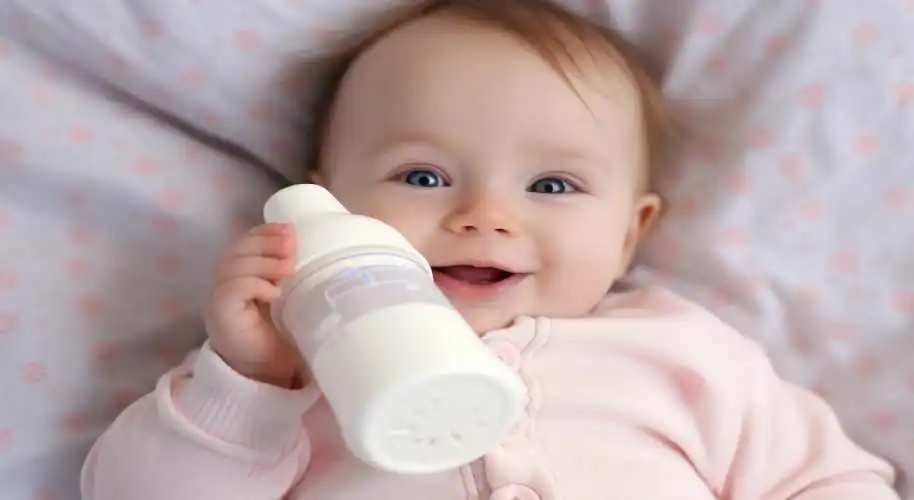Last Updated on August 18, 2023
As new parents embark on the thrilling journey of nurturing their little ones, a myriad of questions and concerns arise. One common query is whether babies can safely enjoy the cold formula. The good news is that yes, babies can indeed consume cold formula. It’s considered safe and acceptable under certain conditions.
Properly prepared and refrigerated formulas can be a convenient option, especially during warmer weather or when on the go. Many babies do not mind or even prefer drinking cold formula, making it a practical choice for parents and caregivers.

Can Babies Drink Cold Formula?
Yes, babies can happily drink cold formula without any worries. Safety is assured as long as the formula is properly prepared and stored in the fridge. Some little ones even prefer the chill, especially in warmer seasons.
Both the American Academy of Pediatrics (AAP) and the Centers for Disease Control and Prevention (CDC) acknowledge that properly prepared and refrigerated formula is safe for infants to consume.
According to registered dietitians Karen Ansel, Elisa Zied, and Dr. Bridget Young, Ph.D., RD, giving babies cold formula can be a safe and convenient option, provided It’s properly prepared and refrigerated.
Dr. Bridget Young says, “As babies grow, they may develop preferences for different formula temperatures. The cold formula is generally safe, but it’s essential to prioritize cleanliness during preparation and adhere to proper storage guidelines.”
As our little ones grow, their preferences might evolve, but by staying mindful of hygiene and safety, we can offer them a comfortable and nourishing feeding experience!
What Happens When You Give a Baby Cold Formula?

Giving your baby cold formula can lead to various reactions. Some babies happily accept it, finding the cool sensation refreshing. Others may prefer warm formulas and be hesitant to use or refuse cold ones.
“The cold formula is generally safe for digestion, but some babies with sensitive tummies could experience mild discomfort or gas”, says Elisa Zied. “It’s crucial to ensure you prepare and store the formula correctly, following the guidelines, and checking the temperature before feeding.”
“Be patient and flexible in discovering what suits your baby’s diet. If your baby seems fussy with cold formula, give it time and consistency for them to adjust, emphasized Zeid.
They might prefer a warm formula, like a cozy hug in a bottle. That’s okay! Just be patient and gentle, and they might come around to the cool idea over time.
“Just like us, babies have their own tastes, and it’s all part of their unique journey. So, enjoy these feeding moments, whether they love the chill or ask for warmth!, Zeid told us”.
Is It Safe to Feed Babies Cold Milk?
“Feeding babies cold milk is safe when handled properly. Correctly prepared and refrigerated breast milk or formula is entirely safe for infants, says Karen Ansel.”
“Moreover, cold milk can benefit teething babies in several ways. “The cool temperature provides a soothing effect, alleviating discomfort and reducing gum inflammation. It helps keep teething babies hydrated, counteracting the effects of increased drooling, adds Ansel.”
Plus, cold milk’s refreshing taste can stimulate appetites and encourage people to eat. The act of breastfeeding or bottle-feeding with cold milk offers emotional support and a pleasant distraction during teething challenges.
Can You Reheat the Cold Formula?

Reheating cold formula is a common concern among parents seeking to ensure their baby’s comfort during feeding. When reheating, it’s essential to follow these guidelines:
Use Safe Methods
Never use a microwave to reheat the formula. Microwaving can create hot spots in the milk, which may burn your baby’s mouth. It’s best to avoid this method and choose safer ways to warm the milk, ensuring your baby’s safety during feeding times.
Warm Water Bath
The recommended method is to place the bottle of cold formula in a bowl of warm water. Be cautious not to make the water too hot, as overheating can destroy nutrients and potentially harm your baby. Then, gently swirl the bottle to ensure even warming.
Check the Temperature
Before feeding your baby, always check the formula’s temperature by placing a drop on your inner wrist. The milk should feel comfortably warm, like body temperature, around 98.6°F (37°C), to prevent any burns or discomfort while ensuring your baby enjoys their meal.
Feed Immediately
Once you have reheated the formula, feed it to your baby immediately. Discard any unused portion of the formula to avoid bacterial growth.
“Reheating cold formula has a few downsides too. It may lead to nutrient loss and altered taste. Bacterial growth can occur if the formula is left at room temperature after reheating. Repeated reheating can be time-consuming and affect the formula’s texture.”
If your baby prefers warm formula, occasional reheating is okay using safe methods like a warm water bath or bottle warmer. Remember, if your baby is content with cold formula, there’s no need to reheat it.
You Might Also Like These Resources!
- Unlock the Secret to Perfectly Storing Your Baby Swing!
- When should a baby stop using swing?
- Could Swinging Your Congested Baby to Sleep be the Secret Solution?
What Are the Pros of Babies Drinking Cold Formula?
Certainly, there are tons of reasons to consider offering your baby a cold bottle of milk.
It’s Quick to Prepare
Unlike warm formula, which requires heating, cold formula is instantly available, saving time and effort during feeding. Cold formula eliminates the need for heating, providing an instant solution for feeding. This time-saving benefit is particularly helpful during busy or urgent situations, making it convenient for caregivers and parents alike.
It’s Refreshing
The cooler temperature of cold formula can be soothing for babies, especially in warmer weather. This refreshing sensation may offer comfort and relief, contributing to a more enjoyable feeding experience for the little one.
Preserves Nutrition
By avoiding repeated heating and cooling, the cold formula helps maintain the integrity of essential nutrients, ensuring that the baby receives the full nutritional value from the formula. This preservation supports healthy growth and development in infants.
It Offers an Easier Transition
The early introduction of the cold formula allows babies to adapt to different temperatures, facilitating a smoother transition to various feeding methods as they grow. This flexibility can be beneficial for both parents and the baby’s feeding routine.
Babies Can Do It on Their Own
Cold formulas allow babies to regulate their intake independently, drinking at their own pace in response to their hunger and satiety cues. This self-regulation can promote healthy eating habits and a sense of autonomy for the child.
It Keeps your Baby Hydrated
The attraction of cold formula can motivate babies to consume more fluids, supporting improved hydration, particularly during situations such as teething or when they resist warm milk. Proper hydration is essential for promoting overall health and well-being in infants.
Are There Any Cons to Babies Drinking Cold Formula?
While giving babies cold formula has its benefits, it’s essential to be aware of some of its downsides.
Temperature Preference
Some babies may have specific temperature preferences and might prefer warm milk. Meeting their preferences can help avoid potential feeding challenges and ensure a smoother feeding experience for both parent and child.
Digestive Sensitivity
Babies with sensitive tummies may experience mild discomfort or gas when consuming the cold formula. Taking their digestive sensitivity into account can lead to a more comfortable feeding experience for the baby.
Nutrient Loss
Repeated heating and cooling of formulas can lead to the loss of essential nutrients, impacting the overall nutritional content. Opting for alternative methods, like cold formula, can help preserve vital nutrients for the baby’s growth and development.
Bacterial Growth
Each time formula is reheated, there is a risk of bacterial growth if the milk is not consumed immediately. Following safe reheating practices is vital to ensuring the formula remains free from harmful bacteria and promotes the baby’s well-being.
Texture and Taste
Texture and taste play a significant role in a baby’s feeding experience. Frequent heating and cooling of the formula can alter its sensory qualities, affecting how it feels in the mouth and its overall taste. Babies are sensitive to these changes, and if the formula undergoes too many temperature fluctuations, they might become hesitant or refuse to eat it.
Formula Feeding During Cooler Months
Formula feeding during cooler months, like winter, requires some extra care and attention to keep your baby comfortable and healthy. Use feeding time as an opportunity for bonding and cuddling with your baby. The warmth of your embrace can provide comfort and reassurance during the cooler months.
Here are some tips to ensure a smooth and safe feeding experience:
Prepare for Outings
If you’re going out, take some time to prepare your baby’s meal. Boil water and let it cool a bit. It’ll be warmer than needed, but that’s okay! Before you go out, measure the formula powder and keep it in a container or baby bottle without liquid. When it’s time to feed your baby, mix the warm water with the formula, and it’ll be perfect!
Insulated Bag
Before heading out, make sure you have enough pre-measured formula and clean bottles. Carry extra supplies in case of unexpected delays. Use an insulated bag to keep prepared bottles warm while you’re out. This is useful in cold weather when the formula can cool quickly.
Be Mindful of Illness
During the colder months, babies may be more susceptible to illness. Pay attention to signs of a cold or respiratory issues that might affect their feeding comfort. If they seem uncomfortable or show signs of being too cold, adjust their clothing or try offering a warmer formula.
If you have any concerns or questions about formula feeding during the cooler months, don’t hesitate to consult with your pediatrician for personalized guidance.
Should You Use Boiling Water for Baby Formula?
Yes, it’s essential to use boiled water for preparing baby formula, especially for infants under 12 months old. Boiling water is a safety measure to ensure that any harmful bacteria or pathogens present in the water are killed, making it safe for your baby to consume.
Here are the steps to prepare baby formula with boiled water:
Boil Water
Bring the water to a rolling boil for at least one minute. Use fresh water from the cold tap for each batch of formula.
Cool Water
Allow the boiled water to cool to the desired feeding temperature. You can use a clean bottle or container to store the boiled water in the refrigerator until needed.
Add Formula
Once the water has cooled, add the appropriate amount of formula powder according to the manufacturer’s instructions. Follow the correct formula-to-water ratio to ensure your baby receives the right nutrition.
Mix Thoroughly
Shake or stir the bottle well to dissolve the formula powder completely.
Check the Temperature
Always check the formula’s temperature on the inside of your wrist before feeding your baby.
Safely Prepare, Use, and Store Formula for Babies
When it comes to feeding your little one, safety is a top priority. Follow these essential pointers to ensure a happy and healthy formula-feeding journey:
Clean Hands, Clean Feeding: Wash hands before handling formula and feeding equipment.
Sterilize for Safety: Sterilize bottles and nipples before first use to keep things germ-free.
Thoroughly Mix: Stir the formula thoroughly for a smooth and consistent mix.
Feed Promptly, No Waiting: Offer the prepared formula right away.
No Leftovers, Toss Away: Discard any unused formula to avoid contamination.
Refrigerate Properly: Store prepared formula in the fridge, not the freezer, and use it within 24 hours.
Safe Warming, No Microwave: Use a bottle warmer or warm water bath for gentle heating, avoiding the microwave.
Check Expiry, Stay Fresh: Always use the formula before the expiration date.
Burp Baby, Comfort, and Glee: Burp your little one during and after feeding to ease discomfort.
Is There Anything Else to Worry About When Giving Babies Cold Formula?
You might be wondering why some mothers still prefer warm milk while rejecting harmless cold formulas. Breastfed babies are used to warmth, and that’s why some may take time to adjust to the cold formula in a bottle. But don’t worry, it won’t stop them from having or liking cold formulas.
Also, some parents worry about liquid separation in stored breast milk. No need to fret, it’s normal and won’t affect the baby’s nutrition. A few swirls, and it’s ready to serve!
FAQs
What Should I Do If My Baby Refuses Cold Formula?
If you have a little one that keeps rejecting cold formula, try warming it up with a bottle of warmer or warm water. Some babies prefer room-temperature formulas too. Be patient and keep trying, their tastes may change. If you’re concerned, chat with your pediatrician for expert advice and support.
Baby Bottle Warmer-Is It Necessary?
A baby bottle warmer can be a super handy gadget for heating bottles quickly and evenly. It’s great for busy parents during nighttime feedings or when you’re out and about. But don’t worry if you don’t have one! You can still warm bottles with a warm water bath or by letting the milk reach room temperature. It’s all about what works best for you and your baby’s needs.
What if My Baby’s Formula is Too Cold?
If your formula is too cold, the baby might show signs of discomfort or refuse to drink it. Drinking very cold formula could cause temporary digestive discomfort or upset. To avoid this, aim for a comfortably warm temperature, similar to body temperature (around 98.6°F or 37°C), which most babies prefer
Wrapping Up
As a new parent, every decision counts, and the temperature of the formula is no exception. Ensuring your baby’s safety and comfort during those precious feeding moments is paramount. Striving to find the perfect balance between safety and coziness is part of the beautiful journey of parenthood.
While some babies may happily accept the cold formula, others might prefer it warmed. If your baby rejects cold formula, no worries! You can try offering it at room temperature or gently warmed.
Remember, every baby is different, so finding their preference will ensure a delightful feeding journey for both baby and parent. Trust your instincts, and cherish every moment with your precious bundle of joy.
Sharing is Caring!
You Might Also Like These Latest Content

Dr. Leah Alexander is a board-certified general pediatrician who has been in practice for over 20 years. She began working as a pediatrician at Elizabeth Pediatric Group of New Jersey in 2000. Since 2005, she has been working as an independently contracted pediatrician with Medical Doctors Associates at Pediatricare Associates of New Jersey. Read more
